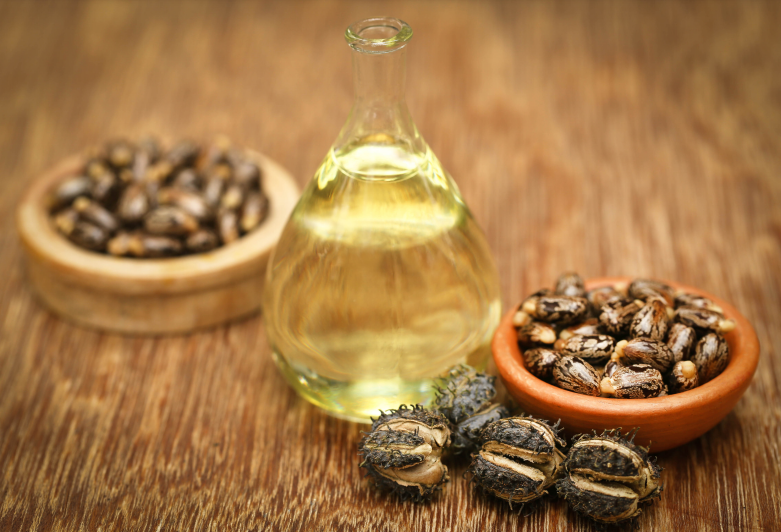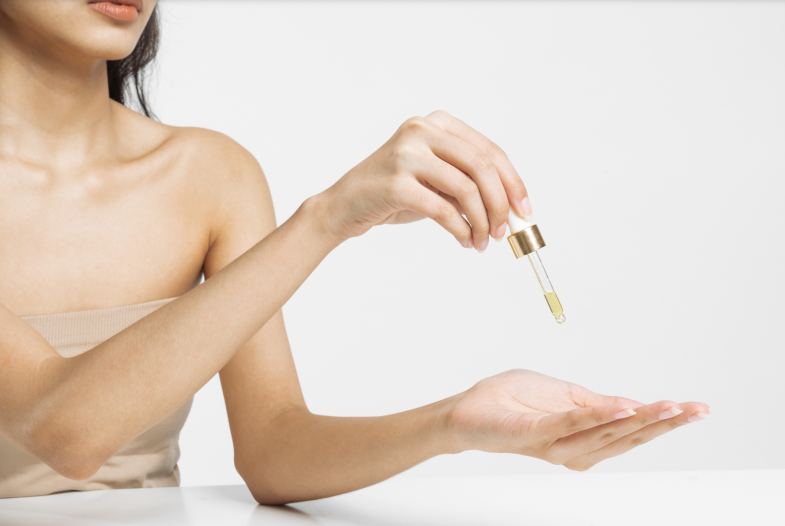Have you tried using castor oil for skin? Castor oil, a versatile and ancient remedy, has been used for millennia for its therapeutic properties. Extracted from the seeds of the Ricinus communis plant, this oil is gaining renewed attention for its potential in skincare.
Whether you’re a beauty aficionado or just looking for natural ways to enhance your skin, castor oil may be a noteworthy addition to your routine.
Here, I’ll explain what castor oil is and how it can help your skin, and I’ll discuss its benefits and tips on how to utilize castor oil for skin.
What Is Castor Oil?
Castor oil is a kind of vegetable oil derived from the castor bean plant. These plants can be found in arid, warm regions of Eastern Africa, Asia, and the Mediterranean Basin. People will press the seeds of the castor bean plant, which produce a clear, light yellow oil, to obtain the oil.
Castor oil has been utilized for a variety of purposes for at least thousands of years. It was used by the Egyptians, Greeks, and Romans. It was used to treat skin and stomach issues, but it was also utilized as fuel.
It is still used today to moisturize the skin and hair, as well as to treat gastric problems, among other things. Castor oil is widely utilized around the world and in many different cultures.
Benefits of Castor Oil for Skin

Moisturization
At the heart of castor oil’s moisturizing properties is ricinoleic acid. This unique fatty acid, comprising about 90% of the oil’s content, is known for its impressive ability to retain moisture.
When applied topically, castor oil creates a protective barrier on the skin, locking in hydration. This barrier not only prevents the loss of water from the outermost layer of the skin but also ensures the skin remains soft, plump, and hydrated for longer periods.
The effect is especially significant for those with naturally dry skin or those living in harsh, dry climates. As moisture retention improves, the skin’s overall texture and feel noticeably become more resilient and less prone to flakiness or rough patches.
Anti-inflammatory
One of the lesser-known but profoundly impactful benefits of castor oil is its anti-inflammatory properties. When applied to inflamed or irritated skin, such as in cases of acne, sunburn, or even allergic reactions, castor oil acts as a soothing balm.
It can reduce redness, swelling, and the sensation of pain or itchiness. The ricinoleic acid plays a pivotal role here too, addressing inflammation at a cellular level and promoting a balanced skin environment.
This quality can be a lifesaver for those with sensitive skin types or conditions like rosacea, where inflammation is a recurrent issue.
Enhances Softness
Over time and with regular application, castor oil can dramatically enhance the skin’s softness. Beyond mere hydration, its rich, viscous texture provides the skin with essential nutrients and fatty acids.
These components help in the natural regeneration of the skin’s surface, leading to the shedding of dead skin cells and the emergence of a fresh, soft layer underneath.
As the skin becomes more nourished, it also becomes more receptive to the oil’s benefits, fostering a virtuous cycle of care. This can be particularly beneficial for areas prone to roughness like elbows, knees, and heels.
Promotes Healing
Nature has imbued castor oil with incredible healing properties. Whether it’s a minor cut, a sunburn, or acne scars, castor oil has shown a propensity to expedite the healing process.
How does it achieve this? Firstly, its anti-inflammatory nature reduces irritation, making it easier for the body to focus on repair.
Secondly, it improves blood circulation in the applied area, ensuring that a fresh supply of oxygen and nutrients reaches the skin cells. This boosts cell turnover and regeneration.
Lastly, the moisturizing aspect ensures that the skin remains supple and less prone to forming hard, rigid scars.
Reduces Wrinkles
Aging is a natural process, but premature aging often stems from a lack of proper skin care, excessive sun exposure, and dehydration.
Castor oil, with its profound hydrating properties, can play a pivotal role in improving skin elasticity. As the skin becomes more hydrated and nourished, it regains some of its lost elasticity, making it firmer and reducing the appearance of fine lines and wrinkles.
Additionally, the antioxidants in castor oil combat free radicals, which are often responsible for accelerating the aging process. With regular use, the oil can provide a more youthful, radiant complexion, slowing down the signs of aging.
How To Use Castor Oil for Skin

Direct Application:
- Cleanse your skin to remove dirt and makeup.
- Take a few drops of castor oil on your fingertips.
- Gently massage the oil onto your face or the desired area in a circular motion.
- Leave it on overnight for an intensive treatment or rinse off after 30 minutes if preferred.
Mixed with Essential Oils:
- Depending on your skin concern, choose an essential oil like lavender for calming, tea tree for acne, or chamomile for soothing.
- Mix 1 tablespoon of castor oil with 2-3 drops of the chosen essential oil.
- Apply the mixture to your skin and massage gently.
- Rinse off after 20-30 minutes or leave it on overnight.
Click here to buy lavender oil, or tea tree oil.
Oil Cleansing Method:
- Take a generous amount of castor oil in your palms.
- Rub your hands together to warm the oil slightly.
- Gently massage the oil into your face for several minutes, ensuring you cover all areas.
- Soak a washcloth in warm water and wring out the excess.
- Place the warm washcloth over your face for a minute to open up the pores.
- Gently wipe away the oil using the washcloth, removing dirt and makeup in the process.
For Chapped Lips:
- Cleanse your lips.
- Dab a small amount of castor oil on your fingertips.
- Gently apply to the lips, ensuring even coverage.
- Reapply as needed throughout the day.
Tips for Using Castor Oil for Skin
Apply Sparingly
Castor oil is very viscous, so a little goes a long way. Start with a small amount, and if you feel the need, you can always add more. This prevents wastage and ensures your skin doesn’t feel too greasy.
Use as an Evening Treatment
Given its thick consistency, many people prefer using castor oil at night, allowing it to deeply moisturize and treat the skin while they sleep.
Avoid Direct Eye Contact
If using castor oil near the eyes, such as for lash growth, be very careful. Direct contact with the eyes might cause temporary discomfort. Using a clean mascara brush or a Q-tip can help in precise application.
Cleanse Properly
If you’re using castor oil as part of the oil cleansing method, always ensure you cleanse properly. Using a warm washcloth can help remove all traces of the oil, ensuring your pores are not clogged.
Storage Matters
Keep your castor oil in a cool, dark place, preferably in its original bottle or a dark-colored glass container. This prevents degradation from sunlight and ensures the oil retains its benefits for a longer period.
Consider Your Skin Type
Castor oil can be heavy for some skin types. If you have oily skin, you may want to mix it with a lighter carrier oil, like jojoba or grapeseed oil, to prevent any potential for breakouts.
Regular Application
Consistency is key. For issues like dry skin patches or scar treatment, regular application of castor oil can produce better results over time. Set a routine and stick to it for optimum benefits.
Related: Boost Your Hair Health: How To Use Rosemary Oil And Castor Oil For Hair Growth [Full Guide]
Side Effects of Castor Oil
Allergic Reactions: Some individuals may be allergic to castor oil, leading to rashes, itching, or hives. A patch test is recommended before widespread use.
Skin Irritation: While rare, castor oil can cause skin irritation in sensitive individuals, manifesting as redness or a burning sensation on application.
Digestive Issues: If ingested, especially in large amounts, castor oil can act as a potent laxative, causing diarrhea, stomach cramps, and dehydration.
Pregnancy Concerns: While used traditionally to induce labor, pregnant women should avoid ingesting castor oil without medical advice due to potential risks.
Interactions with Medications: When ingested, castor oil can interact with certain medications, affecting their absorption or efficacy. Always consult with a medical professional if you’re on medication and considering oral intake.
Overhydration: While castor oil is a potent moisturizer, excessive use can lead to overhydration of the skin, making it too soft or potentially leading to other skin issues.
Most Common Questions Regarding Using Castor Oil For Skin (FAQs)
1. Is castor oil safe for all skin types?
Generally, yes. Castor oil is safe for most skin types. However, those with extremely sensitive skin or specific allergies should conduct a patch test before widespread use.
2. Can castor oil help with acne?
Castor oil has anti-inflammatory properties that can help reduce inflammation associated with acne. However, its thick consistency may not suit everyone, so monitoring your skin’s response is crucial.
3. How often should I apply castor oil to my face?
Depending on the purpose, you can use castor oil 1-3 times a week. For deep moisturization, many prefer using it as a nighttime treatment.
4. Will castor oil clog my pores?
Castor oil is considered non-comedogenic, meaning it shouldn’t clog pores. However, given its thick texture, ensure you cleanse your face properly after usage to prevent any residue buildup.
5. Can I use castor oil to remove makeup?
Yes, castor oil can be an effective makeup remover, especially for stubborn waterproof makeup. It breaks down the makeup and can be rinsed away with warm water or a gentle cleanser.
6. Is castor oil good for under-eye bags and dark circles?
Castor oil can help with moisturizing the delicate under-eye area, and its anti-inflammatory properties may reduce puffiness. However, its efficacy on dark circles varies based on the underlying cause of the discoloration.
7. Can I mix castor oil with other oils or skincare products?
Absolutely! Castor oil mixes well with other carrier oils like coconut or almond oil. Combining it with essential oils or other skin care products can tailor its benefits to specific needs.
8. Is there any difference between castor oil for hair and for skin?
While the intrinsic properties of castor oil remain the same, some products might be specifically formulated or combined with other ingredients optimized for hair or skin. Always read labels and descriptions to ensure suitability for your intended use.
Conclusion
The skin benefits of castor oil are vast and varied. From moisturization to reducing inflammation, it addresses a spectrum of skin concerns. However, always ensure you’re using it in the right way and form that’s suitable for your skin type and needs. As with all skincare products, consistency and patience will yield the best results.
What do you think?
Interested in exploring more about the wonders of ‘castor oil for skin‘? Dive deeper with us into its myriad benefits and applications. Join our community to stay updated on the latest research, user experiences, and expert tips on making the most of this natural elixir. Your path to nourished and radiant skin with castor oil awaits. Connect with us and be part of the conversation.



Comments are closed.